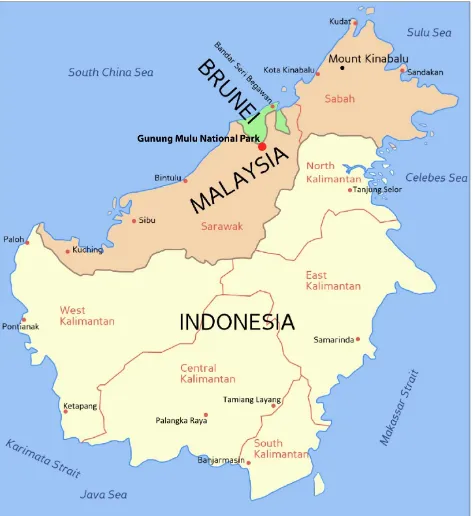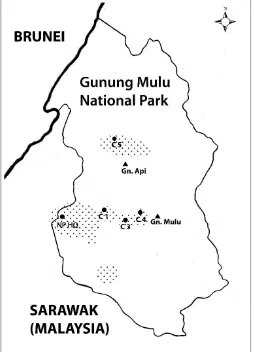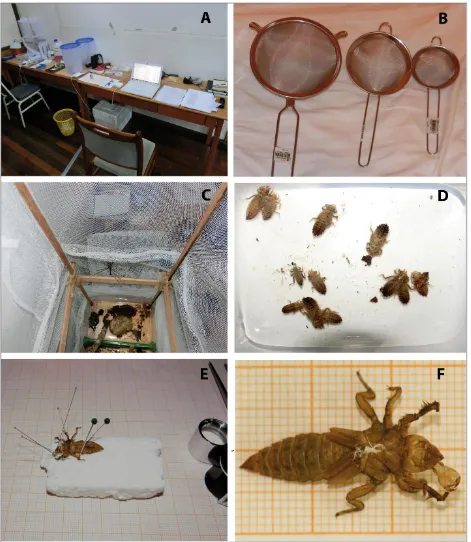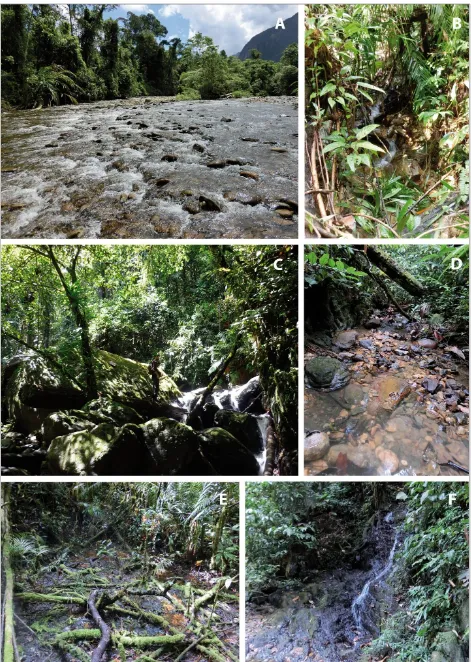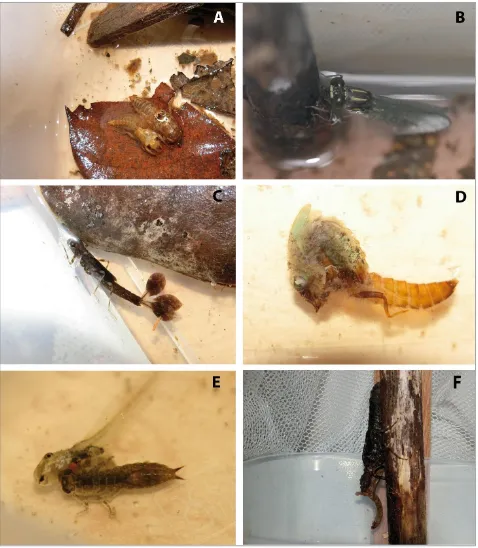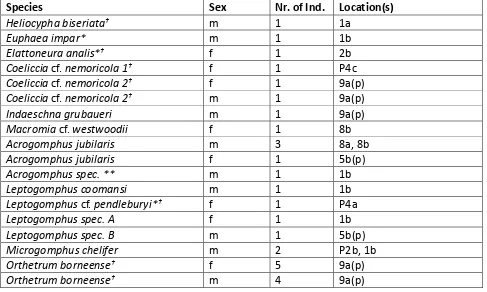Results of Odonata larval rearing in the Gunung
Mulu National Park, Sarawak, Malaysia from
April to August 2014
Article · February 2015
CITATIONS
2
READS
48
1 author:
Philip O. M. Steinhoff
University of Greifswald
10PUBLICATIONS 12CITATIONS
SEE PROFILE
I n t e r n a t i o n a l
D r a g o n f l y F u n d - R e p o r t
Journal of the
International Dragonfly Fund
ISSN 1435-3393
Content
Steinhoff, Philip
Results of Odonata larval rearing in the Gunung Mulu National Park,
Sarawak, Malaysia from April to August 2014 1-11
Internet: http://www.dragonflyfund.org/
This series intends to publish studies promoted by IDF and to facilitate cost-efficient and rapid dis-semination of odonatological data.
Editorial Work: Martin Schorr, Milen Marinov
Layout: Martin Schorr
Indexed by Zoological Record, Thomson Reuters, UK
Home page of IDF: Holger Hunger
Printing: ikt Trier, Germany
Impressum: International Dragonfly Fund - Report - Volume 78
Date of publication: 10.02.2015
Publisher: International Dragonfly Fund e.V., Schulstr. 7B, 54314 Zerf, Germany. E-mail: oestlap@online.de
Results of Odonata larval rearing in the Gunung Mulu National Park,
Sarawak, Malaysia from April to August 2014
Philip O.M. Steinhoff
Department of General and Systematic Zoology, University of Greifswald, Anklamer Straße 20, 17489 Greifswald, Germany
Email: philipsteinhoff@gmail.com
Abstract
Records of larval rearing in the Gunung Mulu National Park, Sarawak, Malaysia carried out in 2014 are presented. In total, larvae of 27 species were collected. Larvae of ele-ven species (22 individuals) were successfully reared out, one individual is currently still being reared. An additional three species were collected right after emergence, with the adult still sitting on its exuvia. Most notable are the samples of Orthetrum
borne-ense, Leptogomphus cf. pendleburyi, Coeliccia cf. nemoricola 1, Coeliccia cf.
nemori-cola 2, Heliocypha biseriata and Elattoneura analis whose final instar larvae are
unde-scribed.
Key words
Odonata; Sarawak; Borneo; Malaysia; larval rearing
Introduction
Between April and August 2014, the odonate fauna of the Gunung Mulu National Park (GM NP) in Sarawak, Malaysia was sampled. The sampling included the collection of adults as well as the collection and rearing of larvae. The results of the adult sampling will be published in combination with data from earlier investigations at a later time (Dow et al. in prep.). Thus, this report focuses on the results of the larval collection and rearing.
GM NP is located in Sarawak, Malaysia on the island of Borneo and with more than
52,800 ha is Sarawak’s largest National Park (NP). GM NP is a rather isolated mountain range in the interior of Sarawak, close to the border of Brunei (Fig. 1). In 2000, the NP was declared a World Natural Heritage by UNESCO (UNESCO, 2000). It is famous for its many, often huge caves that are typical for karst landscapes (Leser, 2009). Also, the NP is characterized by its high biodiversity with a large number of different vegetation types,
which include several types of montane forest. The Gunung (Malay for “Mount”) Mulu
Figure 1. Overview map of Borneo, with GM NP indicated (From Wikimedia commons 2012, modified).
Several surveys to collect odonates have been carried out in GM NP between 2005 and 2012 by R. A. Dow, G. T. Reels and S. G. Butler (cf. Dow et al. 2010 for a summarizing report on the results of some of these fieldtrips). During these surveys, larvae were col-lected and reared too, the results remain to be published.
The main scope of this research project was to collect larvae from montane regions where previously only little fieldwork was carried out. During the four months in Mulu, I additionally sampled other regions relatively low on the mountain that had not been sampled before. A list of the sampling localities is given in Appendix 1, the numbers
refer to Dow et al. (2010). An additional “P” indicates a site that had not been sampled
Research area and methods
A rather large area of the lowland regions of GM NP is easily accessible over a well de-veloped system of trails and boardwalks. There is one trail that leads up the partially very steep Gunung Mulu itself. Along the trail there are three basic shelters, the first (Camp 1) at about 250m a.s.l., the second (Camp 3) at 1300m a.s.l. and the third at about 1800m a.s.l. (Camp 4). Streams on the lower slopes of Gunung Mulu, up to about 700m a.s.l., are accessible from Camp 1 (including an one hour walk up the trail). To access the higher regions of the mountain, a stay at Camp 3 is necessary. For this pro-ject, 2 fieldtrips per month were planned. Each fieldtrip was scheduled with about a week duration. Longer fieldtrips are not advisable, as it is hard to keep many larvae in a fieldcamp. Also, the larvae at base camp should ideally be looked after every day to ensure that freshly emerged adults do not get eaten by ants or fall into the water. Thus a fieldtrip of more than one day requires to find somebody willing and able to take care of the larvae.
Due to several unpredictable factors, such as the severe dryness of high altitude streams in April and May, the frequent unavailability of porters and a forest fire, only three trips to Camp 3 and higher were possible. In addition, I stayed twice at Camp 1 to sample streams on the lower slopes of the mountain. Also, two fieldtrips to the north and very south of GM NP respectively were carried out, where I sampled streams at
about 300-500m a.s.l. The rest of the four months was filled with day trips, during which I tried to sample as many different areas as possible. (See App. 1 for a list of all sampled locations, and Fig. 2 for an overview map).
Every waterbody encountered during a fieldtrip, was searched for larvae, although I especially focused on flowing waterbodies. Habitat types ranged from tree holes over swampy forest pools to open rivers (Fig. 4 A-F). Steep, small streams however, made up the majority of sampled sites.
Figure 3. Details of the larval rearing. A laboratory setup with the larvae cages at the left side, B kitchen
sieves for catching larvae, C freshly emerged Acrogomphus jubilaris in the emergence container, D typical
Figure 4. Examples of sampled locations. A Open stream loc. 12, B streamlet loc. 8b, C rocky stream loc. P4b, D rocky streamlet loc. 5b(p), E swampy pools loc. 9a(p), F waterfall streamlet loc. 5b(p). Photo C by
Figure 5. Images of larval rearing. A Acrogomphus jubilaris exuvia right after emergence of the adult.
Indi-vidual emerged horizontally, larva partially covered by water B Leptogomphus coomansi emerging
verti-cally C Coeliccia cf. nemoricola from a pool at 1300m a.s.l. D Leptogomphus spec. moulting E Indaeschna
grubaueri feeding on tadpole F Tetracanthagyna spec. feeding on small fish. All photos by POMS.
the laboratory. Usually, very small larvae were only collected when the genus was not identifiable or no bigger larvae of the same genus were found (See Fig. 3 D for a typical set of larvae caught at one location).
At base camp, larvae were kept in plastic containers of different sizes, equipped with some sediment from the according sampling sites. Larvae were kept together in one con-tainer only if they were of about the same size, to avoid cannibalism. Also, individuals of
genera that are known to frequently feed on other odonate larvae as Acrogomphus or
Tetracanthagyna were kept separately. Containers that hold stream-dwelling species
were equipped with an additional air pump for waterflow and oxygenation. Containers that contained larvae, which were assumed to be ready or near ready to emerge, were provided with different emergence supports and kept with a tent of mosquito netting, to prevent larvae from escaping and allow a safe maiden flight. See Fig. 3 A, C for photos of the rearing setup. Larvae were fed irregularly with tadpoles, mosquito larvae and small fish (Fig. 5 E-F).
After emergence, the exuvia was positioned on a piece of polysterene. With the help of forceps and insect pins, the legs were spread and the labium was pulled out to simplify subsequent investigations. Insect pins were used to fix the exuvia on the polystyrene, where it was left to dry off (Fig. 3 E-F).
Results
Larvae of 27 species were collected over the research period. Out of those, eleven spe-cies were successfully reared from larva to adult (Tab. 1). The exuvia of three spespe-cies were collected with the adult still sitting on it or next to it, right after emergence (Tab. 1). The larva of one species is currently still being reared. In addition, two exuviae were collected without the adult (Tab. 2).
The actual number of species found may be higher than 27, as many larvae died early and could thus only be determined to genus level (Tab. 2). Also, it is possible that the
Microgomphus and Leptogomphus larvae that could not be reared out, do not
repre-sent additional species. That would reduce the number of collected species to 25. However, for at least 14 collected species, the final instar larva can be linked to an adult (Table 1). Out of those, 6 larvae are undescribed to date.
In flowing waterbodies, larvae of the family Gomphidae were most frequently
encoun-tered. Among those, species of the genus Leptogomphus were most common.
Above ~1200m a.s.l., no larvae were found in flowing waterbodies. Larvae of three
spe-cies, namely Coeliccia cf. nemoricola 2, Orthetrum borneense and Indaeschna
grubau-eri were found in standing waters above ~1200m a.s.l.
Discussion
Table 1. List of larvae reared out. A “cf.” indicates that the identification on species level may not be reliable.
* Species that were collected after emergence and not artificially reared. † Larvae undescribed to date. **
Individual currently still reared.
Species Sex Nr. of Ind. Location(s)
Leptogomphus cf. pendleburyi*† f 1 P4a
Leptogomphus spec. A f 1 1b
Leptogomphus spec. B m 1 5b(p)
Microgomphus chelifer m 2 P2b, 1b
Orthetrum borneense† f 5 9a(p)
Orthetrum borneense† m 4 9a(p)
Table 2. List of collected species not reared to adult. * Indicates species were the exuvia was collected without the adult.
Species Location(s)
Vestalis spec. 5b(p)
Euphaea spec.* 15
Burmagomphus spec. 1a, 1b
Gomphidia spec.* 1b
Heliogomphus spec. 2a, P6a, P6b, 8a, 8b, P8a
Leptogomphus spec. 1a, 1b, 5b(p), 8a, 8b, P6a, P6b, P8a
Macrogomphus spec. 1b, P6b
Microgomphus spec. 1a, 1b
Chlorogomphus spec. P6a, 5b(p)
Tetracanthagyna spec. 8a, 8b, 5b(p)
cf. Macromia spec. 1b, 5b(p), 8a
Orthetrum spec. 1b
Tyriobapta spec. 3a
Lyriothemis cleis 11b
Especially important however, are the six unknown larvae, which will be described from the material collected during this study (Steinhoff et al. in prep.).
Also, for future larval sampling in GM NP, the use of alternative methods should be con-sidered. A big portion of the collected larvae died during the rearing process. Thus, es-pecially a setup that allows the rearing at the waterbody itself, meaning the erection of a cage-like construction in a stream or pool, promises to be fruitful. It would reduce the artificial effects to a minimum and help to keep a natural surrounding. It must however be situated near to base camp, in order to enable daily visits. This restricts the usage, as especially steep mountain streams are not located in the vicinity of the base camp. The rearing of odonate larvae is time consuming and complex, but rewarding in areas like GM NP where so little is known. With an increasing knowledge about the larvae, research in the future can focus more and more on complexes such as seasonality and moult numbers.
With this, the understanding of ecological relationships in threatened ecosystems such as karst landscapes will increase and help to protect those areas.
Acknowledgements
This research project would not have been possible without the great support by Rory Dow, who initially developed the idea for a project outline, organized a collecting per-mit and constantly helped with ID-issues over the course of the 4 months. During a joined trip, Rory Dow and Stephen Butler gave an invaluable in situ introduction into odonata-fieldwork in Borneo. Stephen Butler introduced me into larval rearing tech-niques and constantly helped with larval-ID issues.
I am indebted to the Gunung Mulu Park management and staff, for their constant sup-port, from organisation of porters to the providing of consumable materials and the care-taking of the larvae. Furthermore I thank Martin Schorr, who supported the pro-ject from the start and provided important help with documents. The manuscript was improved by comments from Rory Dow and Stephen Butler. The Sarawak Forest Depart-ment and Sarawak Forestry Corporation granted permits to collect Odonata in Sarawak. Financial support was provided by the German Academic Exchange Service (DAAD) through a PROMOS-scholarship.
References
Dow, R.A., Reels, G.T. & Butler, S.G. 2010. Results of collecting of odonata carried out in Sarawak in 2005-2010. Part IV: Gunung Mulu National Park. Report on collecting of Odonata in Gunung Mulu National Park, 2005-2010; compiled for the Sarawak Fo-restry Department.
Leser, H. 2009. Geomorphologie. Westermann; Braunschweig.
Appendix 1
Nr. Name Habitat GPS coordinates
1a Sungai Paku tributary at the Bat Observatory open lowland stream N4 01.399 E114 49.325 1b Sungai Paku tributary downstream of the Bat
Observatory
open lowland stream N4 01.410 E114 49.191
1c(p) Small tributary of Sungai Paku tributary Sluggish, shady stream N4 01.427 E114 49.185 2a Streams and Rivers around Summit and Deer
Cave Trails and the trail to the Royal Mulu Resort ("Dead End" and "Kenyalang Loop" trails) 2b Swampy areas and forest pools around
Sum-mit and Deer Cave Trails and the trail to the Royal Mulu Resort ("Dead End" and "Kenya-lang Loop" trails)
Swamp and forest pools N4 01.999 E114 48.996, N4 01.877 E114 49.033, N4 01.548 E114 48.297
3a Swamp pools and temporary streams around the Night walk loop
Swamp and temporary streams
N4 02.872 E114 48.931
5a Garden of Eden area, stream flowing into Deer Cave
Rocky, open stream N4 01.884 E114 50.031
5b(p) Garden of Eden area, tributaries of stream flowing into Deer Cave
small, steep streams N4 01.784 E114 50.131, N4 01.788 E114 50.280, N4 01.757 E114 50.164 6a Long Lansat, main stream open lowland stream
6b Long Lansat, tributaries of main stream small, steep streams 7a Main stream at Camp 1 Rocky, open mountain
stream
N4 02.944 E114 51.499
7b Smaller streams near Camp 1 Sluggish, shady streams N4 02.907 E114 51.579, N4 02.866 E114 51.666, N4 03.007 E114 51.477 7d Large stream crossed by summit trail shortly
before junction with Sarawak Chamber trail
Rocky, open mountain stream
N4 03.249 E114 51.235
8a Between Camp 1 and Camp 3, streams at Camp 2
small, steep streams N4 02.433 E114 52.265, N4 02.510 E114 52.278 8b Between Camp 1 and Camp 3, streams away
from the trail slightly lower on the mountain
small, steep streams N4 02.538 E114 52.265, N4 02.573 E114 52.209, N4 02.617 E114 52.162 9a(p) Forest pools near to and above Camp 3 forest pools N4 02.282 E114 53.252,
N4 02.212 E114 53.437 9b(p) Stream at km 11.5 near to Camp 3 small, steep streams N4 02.294 E114 53.155 9c(p) Stream "Jeffry" at km ≈12.6 (down left of the
trail)
small, steep streams N4 02.194 E114 53.486, N4 02.230 E114 53.493 9d(p) Stream above km 13 (down right of the trail) small, steep streams N4 02.107 E114 53.474,
N4 02.094 E114 53.486 10 Streams on the old trail to the Sarawak
Chamber
Densely vegetated low-land streams
11a Streams in alluvial forest close to Sungai Me-linau and to Park buildings at base camp as far as streams on trail to Moon Milk cave
Sluggish, shady stream N4 02.770 E114 48.727, N4 03.037 E114 48.888, N4 03.229 E114 49.358 11b Pools and treeholes in alluvial forest close to
Sungai Melinau and to Park buildings at base camp as far as streams on trail to Moon Milk cave
forest pools and tree-holes
N4 03.037 E114 48.888
12 Sungai Melinau upstream from Park HQ (un-til Camp 5)
open lowland streams/ rivers
Nr. Name Habitat GPS coordinates
14a Streams crossing the trail between Sungai Melinau (Kuala Litut) and Camp 5
Sluggish, shady streams N4 08.206 E114 52.552
14d(p) Streams somewhat away from trail between Sungai Melinau (Kuala Litut) and Camp 5
Sluggish, shady streams N4 08.168 E114 53.068
15 Sungai Melinau at Camp 5 open lowland streams/rivers
N4 08.162 E114 52.462
P1a Sungai Melinau Paku upstream from Bridge (Deer Cave Trail)
open lowland stream N4 02.272 E114 49.773
P1b Sungai Melinau Paku downstream from the Bridge (Deer Cave Trail)
open lowland stream N4 01.586 E114 48.649
P2a Sungai Lupar upstream from Botany Loop Densely vegetated low-land streams
N4 02.403 E114 49.025
P2b Small muddy tributaries of Sungai Lupar Sluggish, shady streams N4 02.436 E114 49.087 P3a Paku Valley Loop, swampy areas and
swampy streams P4a Area east (outside) from the garden of Eden,
stream flowing into Deer Cave (upstream from Waterfall)
Rocky, open mountain stream
N4 01.671 E114 50.387
P4b Area east (outside) from the garden of Eden, big tributary of a, joining at the Waterfall
Rocky, open mountain stream
N4 01.730 E114 50.566
P4c Area east (outside) from the garden of Eden, tributaries of a and b
small, steep streams N4 01.759 E114 50.395, N4 01.701 E114 50.363, N4 01.594 E114 50.578 P5a Camp 4 area, tributary of Sungai Tapen,
down at Camp 4
small, steep stream N4 02.507 E114 54.825
P6a Streams crossing "researchers trail" to Bat Cave
small, steep streams N4 07.946 E114 54.144, N4 07.778 E114 54.266, N4 07.766 E114 54.302, N4 07.748 E114 54.314 P6b Streams away from "researchers trail" to Bat
Cave
small, steep streams N4 08.041 E114 54.030, N4 07.962 E114 54.093 P7a Sandy pools and streams on the Bat Cave
Plateau
sandy pools and streams N4 07.721 E114 54.493
P7b Partially submerged streams on the Bat Cave Plateau
Limestone rock forma-tions with partially sub-merged streams
N4 07.713 E114 54.604
P8a Streams in area southeast of Sungai Long Lansat P8b Tributary streams in area southeast of
Sungai Long Lansat
International Dragonfly Fund - Report is a journal of the International Dragonfly Fund (IDF). It is referred to as
the journal in the remainder of these instructions. Transfer of copyright to IDF is considered to have taken place implicitly once a paper has been published in the journal.
The journal publishes original papers only. By original is meant papers that: a) have not been published elsewhere before, and b) the scientific results of the paper have not been published in their entirety under a different title and/or with different wording elsewhere. The republishing of any part of a paper published in the journal must be negotiated with the Editorial Board and can only proceed after mutual agreement.
Papers reporting studies financially supported by the IDF will be reviewed with priority, however, authors working in general with Odonata are encouraged to submit their manuscripts even if they have not received
any funds from IDF.
Manuscripts submitted to the journal should preferably be in English; alternatively German or French will also be accepted. Every manuscript should be checked by a native speaker of the language in which it is written; if it is not possible for the authors to arrange this, they must inform the Editorial Board on submission of the paper. Authors are encouraged, if possible, to include a version of the abstract in the primary language of the country in which their study was made.
Authors can choose the best way for them to submit their manuscripts between these options: a) via e-mail to the publisher, or b) on a CD, DVD or any other IBM-compatible device. Manuscripts should be prepared in Microsoft Word for Windows.
While preparing the manuscript authors should consider that, although the journal gives some freedom in the style and arrangements of the sections, the editors would like to see the following clearly defined sections: Title (with authors names, physical and e-mail addresses), Abstract, Introduction, Material & Methods, Results, Discussion, Acknowledgments and References. This is a widely used scheme by scientists that everyone should be familiar with. No further instructions are given here, but every author should check the style of the journal.
Authors are advised to avoid any formatting of the text. The manuscripts will be stylised according to the font type and size adopted by the journal. However, check for: a) all species names must be given in italic, b) the authority and year of publication are required on the first appearance of a species name in the text, but not
thereafter, and c) citations and reference list must be arranged following the format below.
Reference cited in the text should read as follows: Tillyard (1924), (Tillyard 1924), Swezey & Williams (1942). The reference list should be prepared according to the following standard:
Swezey, O. & F. Williams, 1942. Dragonflies of Guam. Bernice P. Bishop Museum Bulletin 172: 3-6.
Rebora, M., Piersanti, S. & E. Gaino. 2004. Visual and mechanical cues used for prey detection by the larva of Libellula depressa (Odonata Libellulidae). Ethology, Ecology & Evolution 16(2): 133-144.
Citations of internet sources should include the date of access.
The manuscript should end with a list of captions to the figures and tables. The later should be submitted separately from the text preferably as graphics made using one of the Microsoft Office products or as a high resolution picture saved as a .jpg or .tif file. Hand-made drawings should be scanned and submitted
electronically. Printed figures sent by the post could be damaged, in which case authors will be asked to resubmit them.
78 2010 Villanueva, Reagan, Philippinen Stereomikroskop
79 2010 Villanueva, Reagan, Philippinen Odonata of the Diomabok-Lake region south of Davao, The Philippines
Follow-up
80 2011 Villanueva, Reagan, Philippinen Odonata of the Catanduanes-Island, The Philippines
81 2012 Villanueva, Reagan, Philippinen Odonata of Dinapique, The Philippines
82 2012 Dow, Rory, UK/The Netherlands Odonata of Kalimantan, Borneo, Malaysia
83 2012 Marinov, Milen, Christchurch Odonata species diversity of the "Eua Island, Kingdom of Tonga" 84 Marinov, Milen, Christchurch Odonata of Solomon Islands
85 2012 Villanueva, Reagan, Philippinen Odonata from Talaingod, Davao del Norte, Mindanao Island, Philippines
86 2012 Do Manh, Cuong, Hanoi, Vietnam Mau Son Mountain Odonata, Vietnam
87 2012/13 Villanueva, Reagan, Philippinen Odonata fauna Mt. Lomot and Mt. Sumagaya, The Philippines
88 2013 Anna Rychla, Ukraine Vorkommen der Arktischen Smaragdlibelle Somatochlora arctica
(Zetterstedt, 1840) in Planregenmooren der polnischen Ostseeküste (S. arctica in bogs along the coast of Polish Baltic Sea)
89 2013 Vincent Kalkman/A.B. Orr, The Netherlands/Australia
Field guide New Guinea Zygoptera
90 2013 Oleg Kosterin, Russia Progress study Cambodia 2013
91 2013 Dejan Kulijer, Bosia & Herzegovina Odonata fauna of karst streams and rivers of South Herzegovina (Bosnia and Herzegovina, West Balkan)
92 2013 Saeed, Muhammad & Fazlullah Gujjar, Haripur, Pakistan
Distribution and diversity of Odonata with emphasis on Gomphidae and Cordulegastridae in the border region of Pakistan and Afghanistan
93 2013 Villanueva, Reagan, Philippinen Odonata from Balabac Islands, Palawan, Philippines
94 2013 Villanueva, Reagan, Philippinen Fieldwork to survey the odonatologically unstudied islands of Balut and Sarangani (The Philippines) and Talaud (Indonesia)"
95 2013 Garrison, Rosser/von Ellenrieder, Natalia, Sacramento, USA
The genus Argia in Costa Rica
96 2013 Villanueva, Reagan, Philippinen Odonata of Surigao del Sur, Philippines
97 2014 Dawn, Prosenjit, Kolkata, India Rheophilous Odonata diversity of protected areas of Chhattisgarh, India
98 2014 Dow, Rory, UK/The Netherlands Sarawak Odonata – documenting the status quo Odonata diversity prior
logging"
99 2014 Xu, Xin, NankaiUniversity,Tianjin, China Odonata of Mt Dabieshan in centre of eastern China
100 2014 Rychla, Anna, Polen Untersuchung der Libellen von westpolnischen Mooren.
101 2014 Dow, Rory, UK/The Netherlands Naming an Onychogomphus from Malaysia
102 2014 Vincent Kalkman/A.B. Orr, The Netherlands/Australia
Field guide New Guinea Anisoptera
103 2014 Marinov, Milen, Christchurch, New Zealand Odonata of Samoa, revisiting the localities from Fraser 1925, 1926, 1927, 1953 and 1956
104 2014 Ahmed Zia, Pakistan Zygoptera in eastern Pakistan
105 2014 Saeed, Muhammad & Fazlullah Gujjar, Haripur, Pakistan
